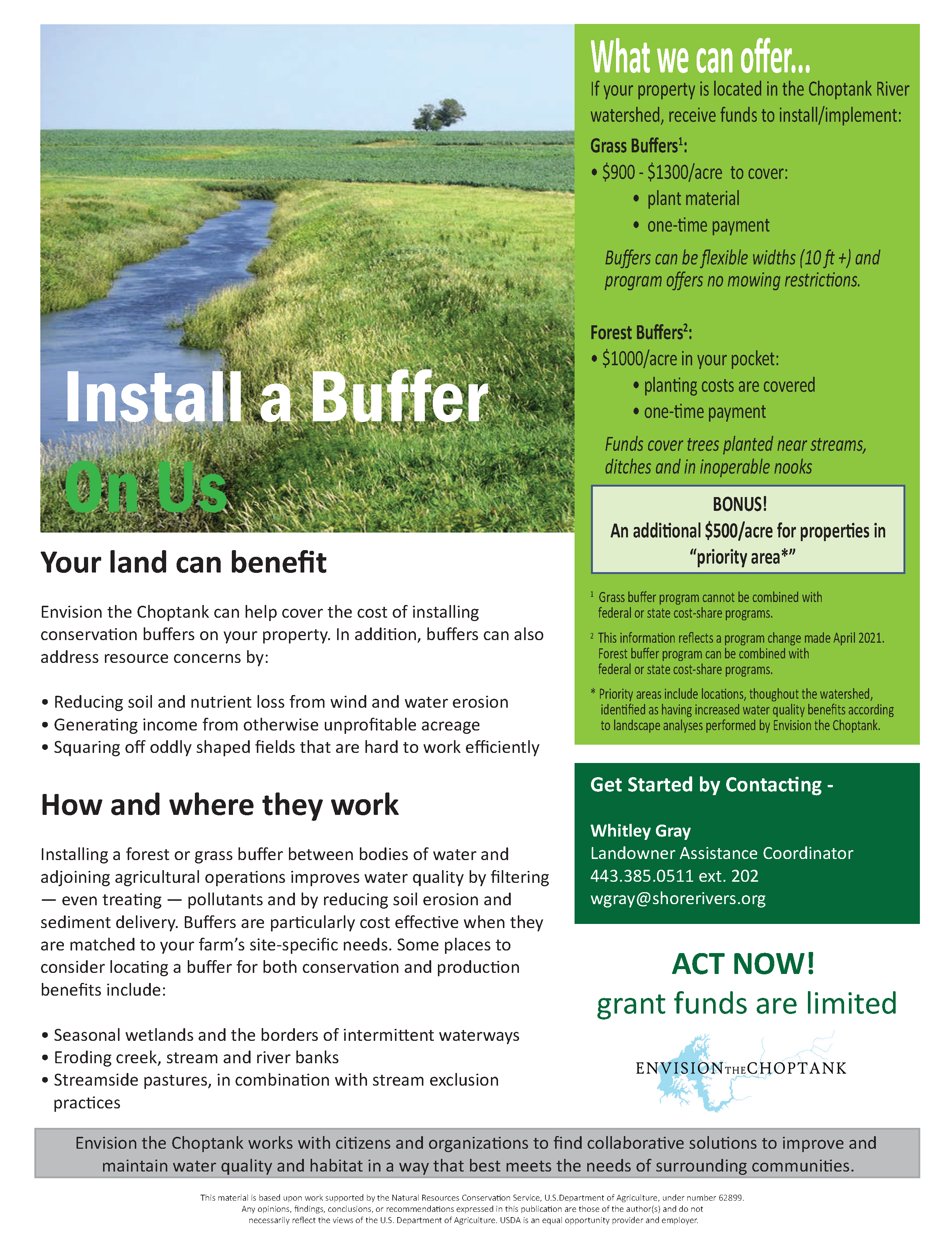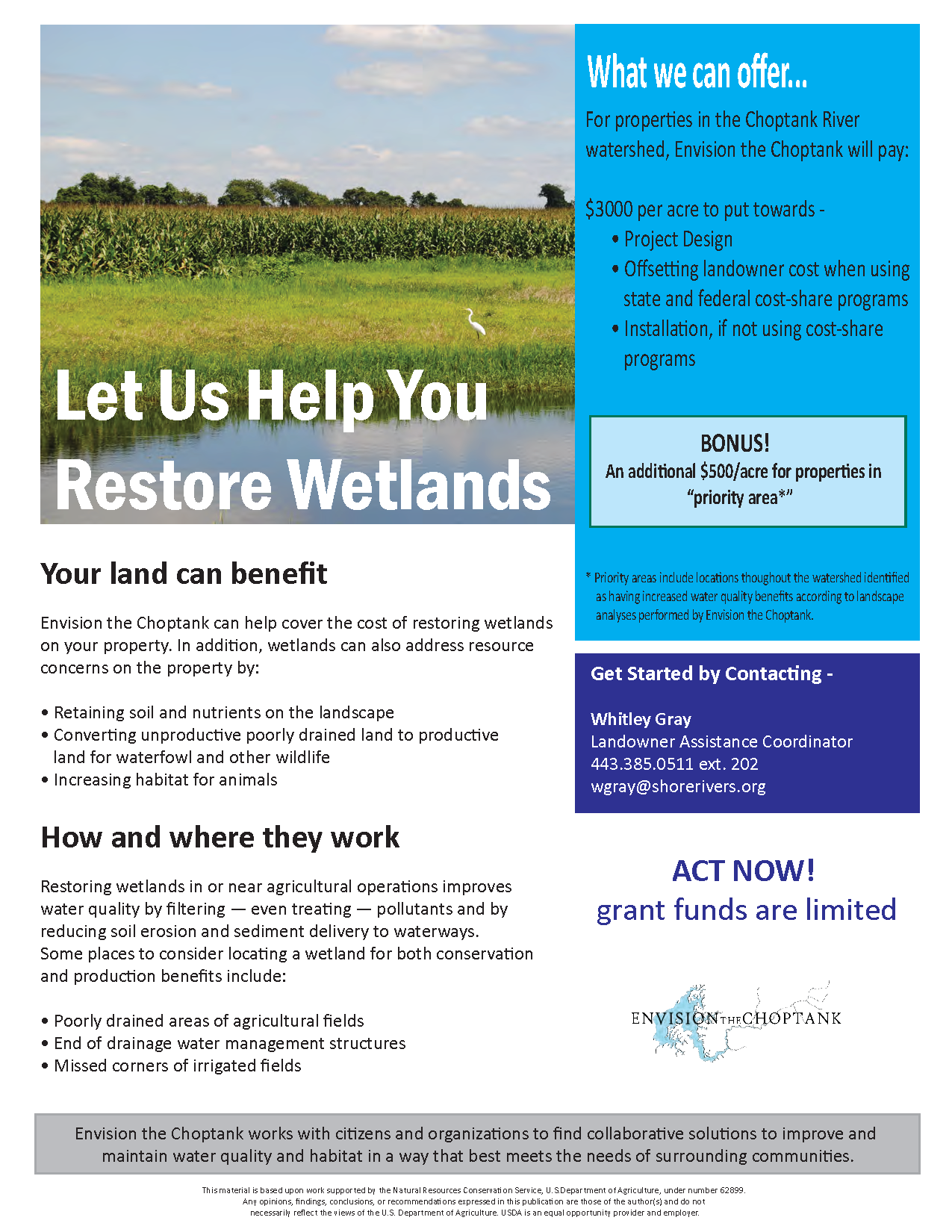Conservation Practices Virtual Education Series: Envision the Choptank
ShoreRivers is a river keeper organization focused on improving water quality in our local rivers and waterways through land-based management, environmental education, and advocacy. They participate in the Envision the Choptank (ETC) partnership with other state, local, and NGOs; Envision the Choptank specifically focuses on efforts to improve water quality, wildlife habitat, and community well-being in the Choptank River watershed.
Envision the Choptank currently has a grant-funded opportunity that offers funding and incentivizes implementation of agricultural best management practices, specifically grass buffers, tree buffers, wetlands, bioreactors, and some ditch practices. These programs are designed to be more flexible than some of the state and federal cost-share programs. Whitley Gray, Landowner Assistance Coordinator at ShoreRivers, acts as a liaison for the program under the Envision the Choptank partnership.

In the Envision the Choptank grass buffer program, there are no restrictions on seasonal mowing, as opposed to state or federal programs where the individual is limited in mowing during the summer season. There is a mowing limit suggested, but because the goal is water quality, there is no formal limit. The grass buffer program also offers flexible width, going as narrow as 10 feet and able to go beyond 50 feet. The grass buffer program runs for three years and requires one native grass and one legume. Payment does differ depending on if you have a warm or cool season grass: warm season would be a $1,300 per acre one-time payment, while cool season would be a $900 per acre one-time payment. When asked about the cost for a landowner to implement this practice, Gray, stated, “If you wanted to do a meadow for a grass, it’s not going to completely fill that price because meadows and flowering plants are more expensive, but if you wanted to just do a switchgrass buffer with a legume in there, you got money in your pocket.”
In the tree buffer program, they plant trees and prefer a 35-foot width buffer or inoperable nooks, which are areas on the landscape that are unable to be harvested or can no longer be accessed. They are currently offering to provide the service for planting the trees, as well as give a $1,000 bonus for each acre installed; participants are also able to do the planting themselves, but that is not a requirement.
There is also a wetlands program that offers $3,000 per acre of wetland restored, and ShoreRivers can also offer an engineer on staff who can design wetlands. Some of these projects are going through the Soil Conservation District and can be coupled with CREP, MDA or other similar incentive programs, but the Envision the Choptank program cannot be coupled Gray stated, “that’s something that I would be very specific with the landowner about, that if you go through our program, we’re going to keep things separate from the Soil Conservation District.”

For each of these programs, ETC requires a confirmation of implementation and will visit the property or accept photos to be sure the practice was installed. Landowners participating in these programs have to manage invasive weeds, but otherwise the functionality of the land is dependent upon preference. The grass buffers can be removed or kept after the three-year mark; tree buffers and wetlands, however, are required for ten years (essentially permanent) and management can vary based on use. Gray commented, “Are you using it for hunting or are you using it as habitat for salamanders and frogs? There is maintenance, but it really depends on the landowner.”
To enroll in these programs, the land must be in the Choptank River Watershed. ETC is primarily interested in working on agricultural properties, but they have also worked with landowners to buffer other waterfront area. With the wetlands program, there are requirements to verify that the soils an appropriate soil type for a wetland. ShoreRivers’ programs are set up to incentivize by providing additional money to the landowner, depending on the practice they are implementing. Other benefits are land stewardship and improved water quality: reducing runoff, nutrients and sediment from getting into local waterways. In some cases for marginalized land, this is a way to gather income where landowners otherwise could not by farming.
Gray recommends looking at all other programs that are available from organizations such as MDA and NRCS, especially considering that ETC does not offer land rental rates, while some state or federal programs do. It is noteworthy that ETC’s program is non-binding with the sale of the land.

A grass buffer that was installed through Envision the Choptank's buffer program on a property in Dorchester County that is also protected by a conservation easement through Eastern Shore Land Conservancy
These practices are shown to be effective at reducing nutrients and sediment and greatly benefit the vast agricultural properties on the eastern shore of Maryland. “I will say one thing that is unique about the Eastern Shore is that the land-water connection is clear,’” Gray noted. “If you’re a farmer in Iowa, you don’t necessarily see the downstream consequences in the Gulf of Mexico; here, we see water quality consequences in our local Chesapeake Bay.”
ShoreRivers and Envision the Choptank offers many volunteer opportunities. Recently, Envision the Choptank hosted a tree planting event in Trappe on March 19th to plant approximately 250 trees. Other volunteer opportunities include trash pickup, event assistance, tree stewards, and many more that can be viewed at www.shorerivers.org/volunteer.






